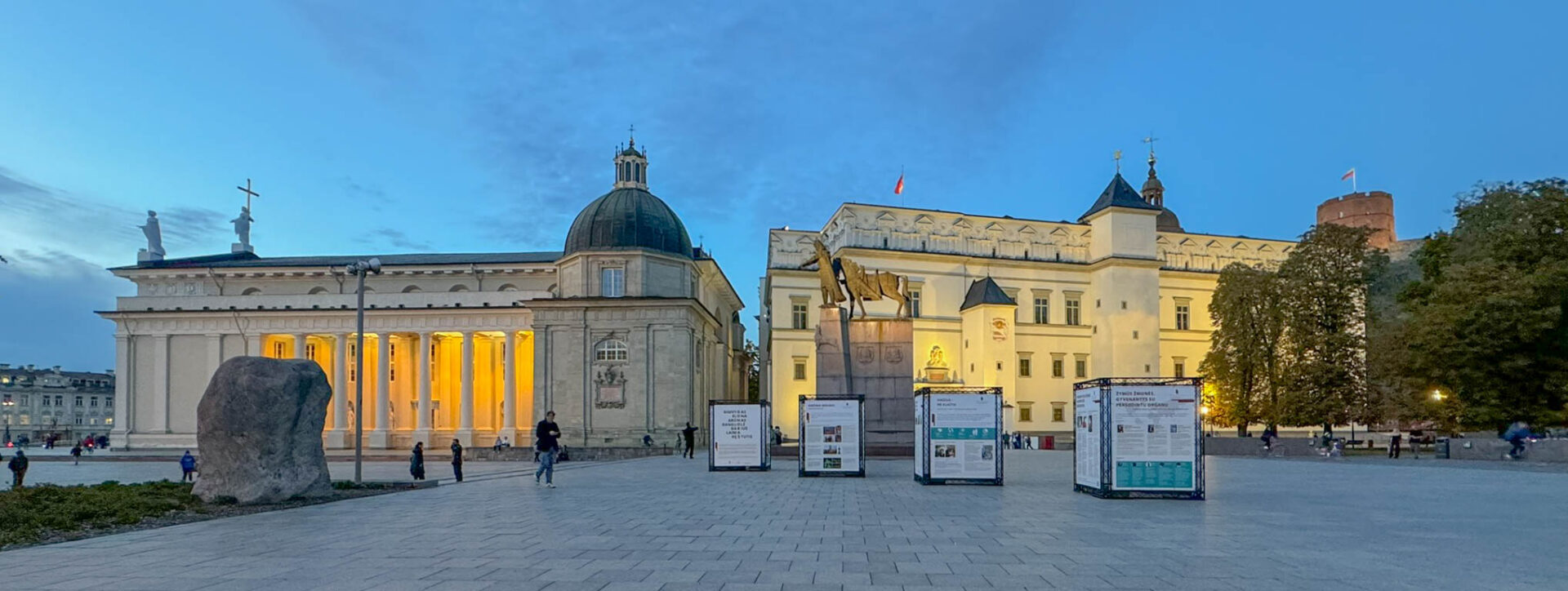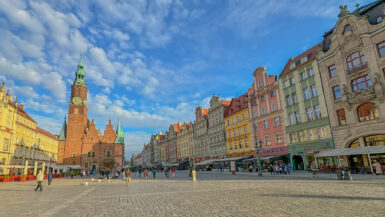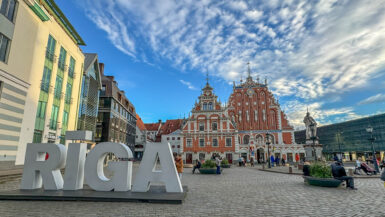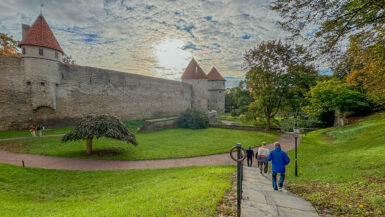Discover Lithuania’s Hill of Crosses and Vilnius: A journey through faith, resilience, and history in the heart of the Baltics.
Ready for the next stop on our Baltic journey? If you’re just joining us, here’s a quick recap: the first post laid the groundwork on the Baltics, the second shared some must-sees in Estonia, and the third zeroed in on some of the highlights of Latvia.
This time, we’re heading to Lithuania, the southernmost of the three Baltic states. With two unforgettable stops at the Hill of Crosses and Vilnius, this leg of the trip was short but packed with unique experiences. Let’s explore what makes these destinations so special.



Table of Contents
The Hill of Crosses: A story of faith, strength, hope, and a Pope
Tucked away in the peaceful Lithuanian countryside, just a ten minute drive from the city of Šiauliai, sits one of Europe’s most unique and moving pilgrimage sites: the Hill of Crosses. With around 200,000 crosses, crucifixes, statues, and rosaries scattered across its slopes, this hill stands as much more than a religious site. It’s a tribute to the unshakable spirit of a nation.

History of the Hill of Crosses
No one knows exactly how the Hill of Crosses became a pilgrimage site, but the story goes that people started placing crosses here to honor sons who never returned from the uprisings in 1831 and 1867. These revolts were against Czarist Russia, which had taken control of Lithuania and absorbed it into its empire. Over time, the Hill of Crosses became a sacred space where Lithuanians could not only practice their faith but also express their yearning for freedom.
By 1900, around 150 crosses stood on the hill. Even after the devastation of World War I, locals continued adding crosses. By the late 1930s, the number had climbed to 400. During World War II, people kept visiting the hill, planting crosses, and saying their prayers.
Fast forward to the 20th century, during the Soviet occupation, and the hill took on an even deeper meaning. After World War II, when the Communist regime tightened its grip, the number of crosses surged to about 5,000. Then, in 1961, the government decided to destroy them all. They bulldozed the hill and blocked roads leading to it. But that didn’t faze the local people. Night after night, Lithuanians quietly returned, adding even more crosses.
In the 1970s, the hill was flattened once more by bulldozers. Undeterred, people came back and planted even more crosses. Then, in 1985, the Russians rolled in for another round of bulldozing, which only inspired locals to return yet again, determined to add even more crosses to the site. Each act of defiance was a declaration that their faith and hope could not be erased, no matter how hard the Soviets tried. Pilgrimages grew even more frequent, turning the site into a quiet but powerful symbol of resistance against an oppressive regime.



The Hill of Crosses today: A monument to strength and unity
Today, the Hill of Crosses stands as a powerful symbol of faith and resilience. Visitors from all over the world come to leave their own crosses, creating an ever-growing tapestry of prayers, memories, and promises. Every cross holds meaning – a whispered wish, a moment of gratitude, or a tribute to someone loved and lost.
According to a display at the site, there are over 200,000 crosses at the Hill of Crosses. This number grows every single day as people from all corners of the world arrive, carrying crosses, crucifixes, and other symbols of their faith. Some are tiny and delicate, while others are so big you’d wonder how they managed to lug them all the way there.
Despite its solemn appearance, the hill is far from somber. In its quiet way, it exudes hope and connection. The sight of thousands of crosses, paired with the soft clinking of rosaries swaying in the wind, is both humbling and awe-inspiring.






How Pope John Paul II brought global attention to Lithuania’s Hill of Crosses
On September 7, 1993, the Hill of Crosses became famous when Pope John Paul II visited the site, calling it a place for peace and prayer. His visit cemented its status as a major pilgrimage site. Since then, it’s drawn Catholic pilgrims, tourists, and curious travelers alike, all seeking something – whether it’s spiritual renewal, a moment of reflection, or simply to witness this remarkable symbol of human perseverance.




Tips for Your Visit
Thinking of visiting the Hill of Crosses? Here’s what you need to know:
- Getting There: The hill is about 7.5 miles (12 kilometers) north of Šiauliai. You can drive or catch a local bus to the nearby village of Jurgaičiai.
- Cost / Parking: Visiting the Hill of Crosses is free of charge There’s a nominal fee for parking. The site offers a parking area equipped with a visitor center, souvenir shop, and restrooms. The visitor center’s operating hours are typically from 9:00 AM to 6:00 PM daily. After parking, it’s a short walk to the hill itself.
- Be Respectful: It’s a deeply spiritual place for many, so approach it with the reverence it deserves.
- Best Time to Go: Early mornings or late afternoons tend to have fewer visitors and good light for photos.
- What to Bring: Feel free to bring a cross to leave on the hill. If you don’t have one, you’ll find vendors nearby selling handmade options. Having some cash on you can be useful, whether you’re eyeing a cross from a vendor or just trying to pay for a quick trip to the restroom.

Vilnius: The heartbeat of Lithuania
Consistent with the Baltic theme that we’ve seen so far, Lithuania’s capital city, Vilnius, is where history, art, and culture come together in a way that feels effortless. This hasn’t gone unnoticed, as Vilnius Old Town is a UNESCO World Heritage site in recognition of its universal value and originality, with the largest baroque Old Town in Eastern and Central Europe.
Walking Through Time: Vilnius’ Old Town
Lithuania was founded around 1323 by Grand Duke Gediminas (1275–1341), and it quickly became a key cultural and political center in the Grand Duchy of Lithuania. Over time, influences from Polish, Russian, Lithuanian, and Jewish communities have shaped Vilnius into a rich tapestry of traditions and stories.
To get a true sense of Vilnius’s roots, start with its Old Town. It’s not just any historic district. It’s one of Europe’s largest and best preserved medieval old towns, complete with cobblestone streets, intricate church facades, and centuries-old courtyards.
Must-see spots include:
- Vilnius Cathedral and Bell Tower: Standing tall in Cathedral Square, this neoclassical gem is a city icon. Take the climb up the bell tower for some great views.
- Gediminas’ Tower: Perched on Castle Hill, this tower is all that remains of the city’s medieval castle. It offers a postcard-worthy view of the Old Town below.
- St. Anne’s Church: This Gothic beauty was so admired by Napoleon that he reportedly said, “If I could, I would carry this church back to Paris in the palm of my hand.”
Here’s a photo tour of what you can expect to see in Vilnius’ Old Town.














A City of Creativity
There’s a pulse of creativity running through Vilnius, and you can feel it in its art, music, and quirky neighborhoods. Užupis, a once-overlooked district across the Vilnia River, is now the unofficial capital of cool. Think of it as Vilnius’s answer to Montmartre in Paris – hip, artsy, and full of personality. Back in 1997, Užupis declared itself an independent “republic,” complete with its own flag, anthem, and even a quirky constitution.
As you wander its streets, you’ll spot colorful murals, eccentric sculptures, and a community that embraces free-spirited creativity. Don’t miss the Angel of Užupis, a statue that’s become a symbol of the neighborhood’s playful energy. For more artistic inspiration, check out the MO Museum, which showcases modern Lithuanian art, or the National Museum of Lithuania, where you can dive deeper into the country’s cultural story.
The Legacy of the “Jerusalem of the North”
Once upon a time, Vilnius was known as the “Jerusalem of the North,” home to a thriving Jewish population. Before World War II, it was a major hub of Jewish culture, education, and publishing. Sadly, much of this was lost during the Holocaust.
Today, efforts to honor and preserve this heritage are visible throughout the city. The Vilna Gaon Jewish State Museum and the Holocaust Memorial at Paneriai offer important insights into this chapter of Vilnius’s history. Walking through the former Jewish Quarter can also be a moving experience, connecting past traditions to the city’s modern identity.
Green Spaces in the City
For all its urban energy, Vilnius is surprisingly green. Parks, gardens, and even forests are woven throughout the city, giving locals and visitors a chance to slow down and breathe.
The Bernardine Garden, located near Cathedral Square, is a peaceful spot for a stroll with its manicured paths and calming atmosphere. On the other hand, Vingis Park, the largest in the city, is where Vilnius comes alive with concerts, festivals, and outdoor fun throughout the year.
If you’re up for a bit of a hike, head to Three Crosses Hill. The monument at the top is a striking reminder of Lithuania’s resilience, and the views are worth the climb.
A Taste of Modern Vilnius
While history gives Vilnius its depth, its modern side keeps things exciting. The city’s tech and startup scene is flourishing, with hubs of innovation popping up in neighborhoods like Naujamiestis. There’s also a fresh energy in its cafes, craft breweries, and restaurants, where old Lithuanian recipes are being reinvented for today’s foodies.
If you’re hungry, try local classics like cepelinai (potato dumplings stuffed with meat or cheese) or šaltibarščiai (a vibrant pink cold beet soup). You’ll also find modern takes on Lithuanian cuisine at one of the city’s many farm-to-table spots.


Tips for Visiting Vilnius
- Getting Around: Vilnius is very walkable, especially in the Old Town. For longer distances, buses and trolleybuses are easy to use, and bike or scooter rentals make exploring even more fun.
- Currency: Lithuania uses the Euro (€). Most places take cards, but having some cash for smaller shops or street vendors is handy.
- Best Time to Visit: Late spring and summer are ideal for outdoor events and sunny days. Winter transforms the city into a festive wonderland, with Christmas markets and sparkling lights.
- Day Trips: Vilnius makes a great base for exploring nearby gems like Trakai Castle, a fairytale-like island fortress, or the Hill of Crosses, which you should be familiar with since that was the focus of the first part of this article.

In Closing
A drive through Lithuania is like uncovering a series of interconnected stories, each destination offering its own distinct experience. At the Hill of Crosses, the sheer number of crosses speaks quietly but powerfully to centuries of faith and endurance. In Vilnius, the cobblestone streets lead you through layers of history, where baroque facades meet modern creativity.
Whether it’s the serene countryside or the dynamic pulse of the capital, Lithuania draws you in with a sense of place that feels both grounded and evolving. By the journey’s end, you won’t just have photos and memories. You’ll carry with you a deeper connection to the stories that shape this remarkable country.
For our next stop, we’ll be leaving the Baltics and crossing into Poland for a whirlwind tour of the Wolf’s Lair, Toruń, Wrocław, Auschwitz, and Kraków. I hope you’ll join me for the ride!
Thought for the Week
Similar to last week’s post, this week I’ll share four Lithuanian quotes that provide some good food for thought as well as some insight into the Lithuanian culture.
The first quote from poet and author Kristijonas Donelaitis (1714 – 1780) paints a picture of life that’s full of meaning, where people find purpose through their actions and hard work. In his epic poem The Seasons, Donelaitis depicts the lives of Lithuanian peasants under Prussian rule, focusing on their daily struggles, work ethic, and moral values. In the poem, he highlights the importance of the virtues of hard work, humility, and community. The message is clear: living a fulfilling life isn’t about sitting back and waiting for things to happen. It takes effort, consistency, and a sense of responsibility. This idea ties neatly into age-old values like perseverance, self-control, and contributing to the well-being of your community.
The second quote is from Dalia Grybauskaitė, a Lithuanian politician who served as the 8th president of Lithuania from 2009 to 2019. Freedom is like a delicate plant – hard to grow, easy to ruin, and always in need of attention. Former president Grybauskaitė knew this well. She often reflected on her country’s struggle to shake off decades of Soviet control and reclaim its independence. Her words serve as a reminder that freedom, whether it’s about a nation or an individual, isn’t a one-and-done deal. It’s not something you just earn and file away for safekeeping. Freedom takes constant work. It’s a balancing act that requires us to stay alert and not get too comfortable. Threats can come from outside forces trying to take it away or from within, where apathy and complacency can quietly do just as much damage. Grybauskaitė’s quote nudges us to stay involved, to take responsibility, and to actively protect the values that allow democracy to thrive.
The third quote is from Vincas Kudirka (1858 – 1899), the writer and composer of the Lithuanian national anthem. Kudirka views true strength as the ability to master oneself rather than overpower others. This idea highlights the value of inner discipline, persistence, and self-control. It points out that our toughest battles are often internal – facing fears, resisting temptations, and improving personal flaws. Kudirka’s message inspires growth by reminding us that real power comes from overcoming our own limits, not from controlling others.
“Man was not created to be idle on this earth.” (“Ne tam žmogus sutvertas, kad žemėj tingėtų.”)
― Kristijonas Donelaitis
“Freedom is never a given—it must constantly be defended and nurtured.” (“Laisvė niekada nėra duotybė – ją reikia nuolat ginti ir puoselėti.”)
― Dalia Grybauskaitė
“Strength is not in defeating others, but in overcoming oneself.” (“Ne tas stiprus, kuris kitą nugali, o tas, kuris pats save įveikia.”)
― Vincas Kudirka
Thanks for reading and happy travels!
Mark (The New Mexico Travel Guy)

Mark Aspelin, The New Mexico Travel Guy (www.newmexicotravelguy.com), is a travel writer, conservation biologist, project manager, and author of two books. He’s visited over 100 countries and all 50 U.S. states—just enough to land in the Travelers’ Century Club and make choosing a favorite place nearly impossible. He’s currently on a questionable mission to visit every town in New Mexico (there are over 500) and write a story about each one, with plans to wrap it up sometime before his early to mid 100s. Mark balances his writing with conservation and project work from his home base in the East Mountains near Albuquerque, New Mexico.




